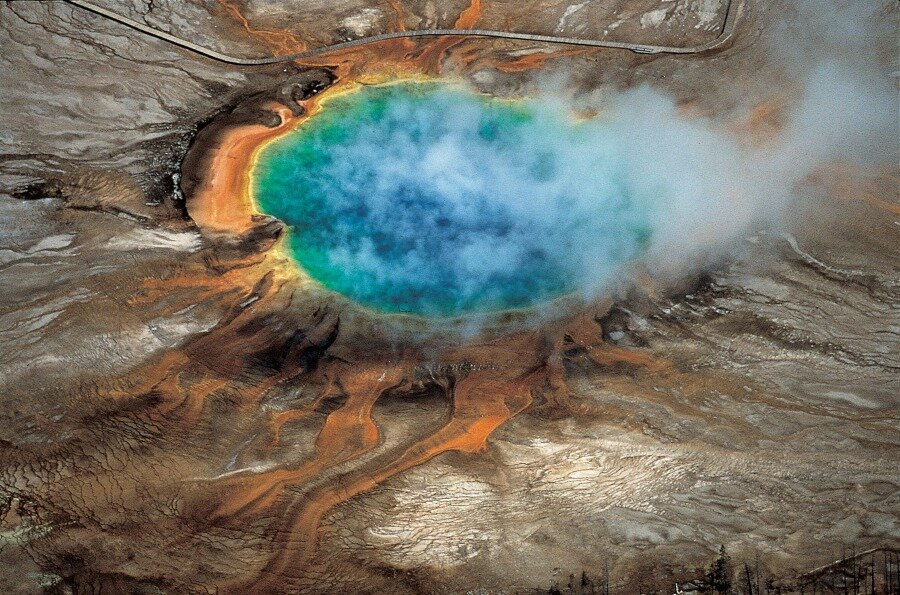Scientists find huge magma reservoir in Yellowstone 'supervolcano'
Loading...
Scientists and tourists have always known that Yellowstone National Park featured lively geologic wonders – regular small earthquakes and two-thirds of the world’s geysers, including Old Faithful – all constituting what’s known as a “supervolcano.”
Now, seismologists at the University of Utah in Salt Lake City have made a new discovery about Yellowstone’s subsurface plumbing, specifically a reservoir of hot, partly molten rock more than four times larger than the shallower magma chamber that scientists already knew about. To give that some perspective, the newly discovered reservoir would fill the Grand Canyon 11 times, compared with 2.5 times for the shallower chamber.
“For the first time, we have imaged the continuous volcanic plumbing system under Yellowstone,” says Hsin-Hua Huang, a postdoctoral researcher in geology and geophysics at the university and the study’s lead author, in a statement. “That includes the upper crustal magma chamber we have seen previously plus a lower crustal magma reservoir that has never been imaged before and that connects the upper chamber to the Yellowstone hotspot plume below.”
The researchers, whose findings were published in the journal Science this week, emphasize that Yellowstone’s plumbing system is no larger – nor closer to erupting – than before. Now, however, they have used advanced techniques to make a complete image of the system that carries hot and partly molten rock upward from the top of the Yellowstone hot-spot plume – about 40 miles beneath the surface – to the magma reservoir and the magma chamber above it.
But the deeper chamber does mean that the shallow chamber can be replenished again and again.
“Knowing that you have this additional reservoir tells you you could have a much bigger volume erupt over a relatively short time scale,” study coauthor Victor Tsai, a geophysicist at the California Institute of Technology in Pasadena, told Science.
There’s evidence that Yellowstone had major eruptions 2.1 million, 1.3 million, and 640,000 years ago – implying that another big one might be “due” sometime within the next 90,000 years. But as the United States Geological Survey (USGS) points out, such calculations are statistically meaningless.
“Nevertheless, we cannot discount the possibility of another such eruption occurring some time in the future, given Yellowstone's volcanic history and the continued presence of magma beneath the Yellowstone caldera,” according to the USGS. “Yellowstone's 2-million-year history of volcanism, the copious amount of heat that still flows from the ground, the frequent earthquakes, and the repeated uplift and subsidence of the caldera floor also testify to the continuity of magmatic processes beneath Yellowstone and point to the possibility of future volcanism and earthquake activity.”
How big would a big one be at Yellowstone? Probably bigger – perhaps many times bigger – than the relatively recent eruptions at Mt. Tambora (1815), Krakatoa (1883), Mt. St. Helens (1980), and Mt. Pinatubo (1991).
“If another catastrophic caldera-forming Yellowstone eruption were to occur, it quite likely would alter global weather patterns and have enormous effects on human activity, especially agricultural production, for many years,” reports the USGS.
Still, that worst-case scenario is also the least likely to happen. More likely would be a hydrothermal eruption from reservoirs of steam or hot water rather than molten rock, blasting out shallow craters that could be more than a kilometer wide – impressive, and you wouldn’t want to be there if it happened.
The most likely type of volcanic eruption, producing lava flows and perhaps significant volumes of volcanic ash and pumice, could range in size from smaller than Mt. St. Helens to larger than Mt. Pinatubo – a major global volcanic event but something less than the three previous catastrophic caldera-forming eruptions.
Could some of the pressure at Yellowstone be released by drilling into the volcano? Probably not.
“Notwithstanding the enormous expense and technological difficulties in drilling through hot, mushy rock, drilling is unlikely to have much effect,” the USGS reports. “At near magmatic temperatures and pressures, any hole would rapidly become sealed by minerals crystallizing from the natural fluids that are present at those depths.”
The University of Utah seismologists note that the annual chance of a supervolcano eruption at the national park still is 1 in 700,000.
No need, in other words, to change any summer vacation plans for Yellowstone.








